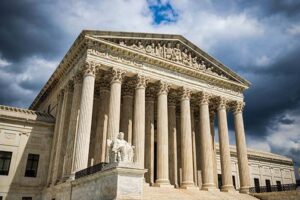 By Gerald L. Maatman, Jr., Jennifer A. Riley, and Derek S. Franklin
By Gerald L. Maatman, Jr., Jennifer A. Riley, and Derek S. Franklin
Duane Morris Takeaways: On May 10, 2024, in Richards v. Eli Lilly & Co., et al., No. 1:23-CV-00242 (S.D. Ind. May 10, 2024), Chief Judge Tanya Walton Pratt of the U.S. District Court For The Southern District Of Indiana granted Eli Lilly’s motion asking the Court to certify for interlocutory appeal the question of whether a plaintiff must show more than a “modest factual showing of similarity” in order to issue notice in a collective action. The Court certified for review by the Seventh Circuit the specific question of “[w]hether notice in a collective action can issue based on a modest factual showing of similarity, rather than upon a showing by a preponderance of the evidence that requires the Court to find that commonality across the collective [action] is more likely than not.” The ruling and the future appellate decision should be required reading for companies involved in wage & hour litigation.
Case Background
Named Plaintiff Monica Richards brought a proposed collective action against Defendants Eli Lilly & Company and Lilly USA, LLC’s (collectively, “Eli Lilly”) under the Age Discrimination in Employment Act (ADEA) alleging that Eli Lilly knowingly and willfully denied promotions to qualified employees who were older than 40, including herself and all other similarly situated employees. Id. at 1.
Plaintiff moved for conditional certification of a proposed ADEA collective action of “[a]ll Eli Lilly employees who were 40 or older when they were denied promotions for which they were qualified, since February 12, 2022.” Id. at 2. Plaintiff’s motion urged the Court to utilize a “two-step” legal standard to evaluate collective action certification established in 1987 by Lusardi v. Xerox Corp., 118 F.R.D. 351 (D.N.J. 1987). Id. at 2. Under the Lusardi framework, plaintiffs need only present what some judges have described as a “modest factual showing” that similar potential plaintiffs exist to satisfy the first step, i.e., certification of a collective action on a conditional basis. Id. In the second step, assuming others have joined the lawsuit as opt-in plaintiffs and the parties have completed discovery on the merits, the court makes a final determination whether the opt-in plaintiffs actually qualify as parties to the litigation on the basis of substantial similarity to the named plaintiffs in what is known as a second-stage final certification order. Id. at 3.
Eli Lilly responded that the Court should follow the recent Fifth Circuit decision in Swales v. KLLM Transp. Servs., LLC, 985 F.4th 430 (5th Cir. 2021), and/or Sixth Circuit decision in Clark v. A&L Homecare & Training Ctr., LLC, 68 F.4th 1003 (6th Cir. 2023), which both rejected the longstanding two-step approach developed in Lusardi in favor of more rigorous one-step processes. Id.
On March 25, 2024, the Court granted Plaintiff’s motion for conditional certification of the ADEA collective action using the two-step Lusardi framework that Plaintiff urged the Court to adopt. Thereafter, Eli Lilly filed a motion asking the Court to certify an immediate appeal on the question of which legal standard courts in the Seventh Circuit should use to evaluate conditional certification of a collective action. Plaintiffs sought review pursuant to 28 U.S.C. § 1292(b). Id. at 2.
Certification Of Interlocutory Appeal
On May 10, 2024, the Court granted Eli Lilly’s motion and certified for interlocutory appeal the specific question of: “Whether notice in a collective action can issue based on a modest factual showing of similarity, rather than upon a showing by a preponderance of the evidence that requires the Court to find that commonality across the collective [action] is more likely than not.” Id. at 12.
In doing so, the Court explained that the certified question met the criteria for an interlocutory appeal under 28 U.S.C. § 1292(b) because it “involves a controlling question of law to which there is substantial ground for difference of opinion and an immediate appeal from the order may materially advance the ultimate termination of litigation.” Id. at 12. The Court further reasoned that “Eli Lilly simply seeks clarity on the proper legal standard for collective certification, not whether the Court appropriately applied the facts to a particular standard,” and that “[t]he Seventh Circuit should be given the opportunity to clarify the standard, should it so choose.” Id. at 6.
Along with certifying the this legal question for appellate review, the Court stayed the issuance of notice to members of the proposed collective action pending the outcome of the Seventh Circuit’s ruling. Id. at 12.
Implications For Employers
The Richards decision is consequential because it will prompt the Seventh Circuit to weigh in for the first time on the applicable legal standard governing what a plaintiff must establish for a court to grant conditional certification of a collective action. While the proposed collective action in Richards concerns claims under the ADEA, the ADEA incorporates the FLSA’s collective action procedures, meaning that the certified question will also impact collective action lawsuits under the FLSA.
As any employer who has been sued by a named plaintiff seeking to represent an FLSA collective action knows, the discovery burden imposed by application of the two-step Lusardi decision is far more onerous than what the Fifth Circuit established in Swales or the Sixth Circuit established in Clark.
On top of the discovery implications, employers litigating FLSA cases in the Seventh Circuit will want to keep a close eye on how it rules in Richards, since it will significantly impact how heavy of a burden plaintiffs will face in order to show they are similarly situated to the individuals they seek to notify of a collective action.









